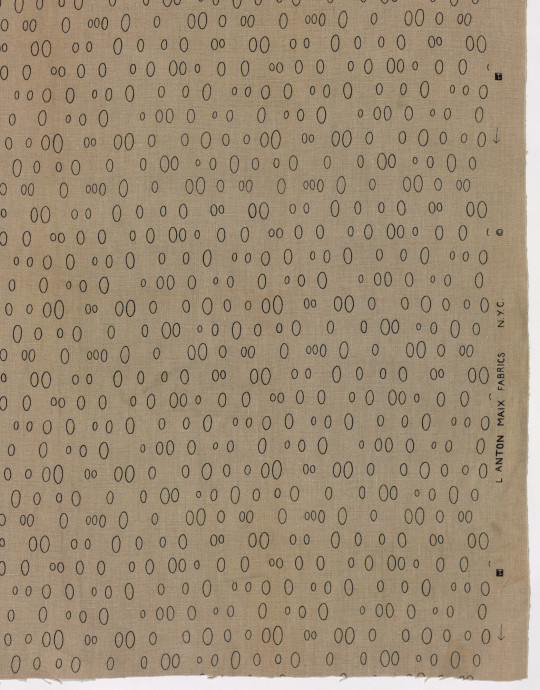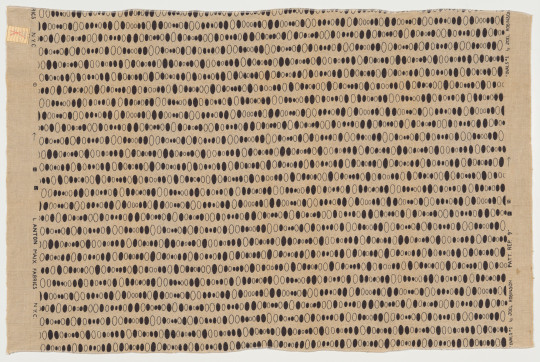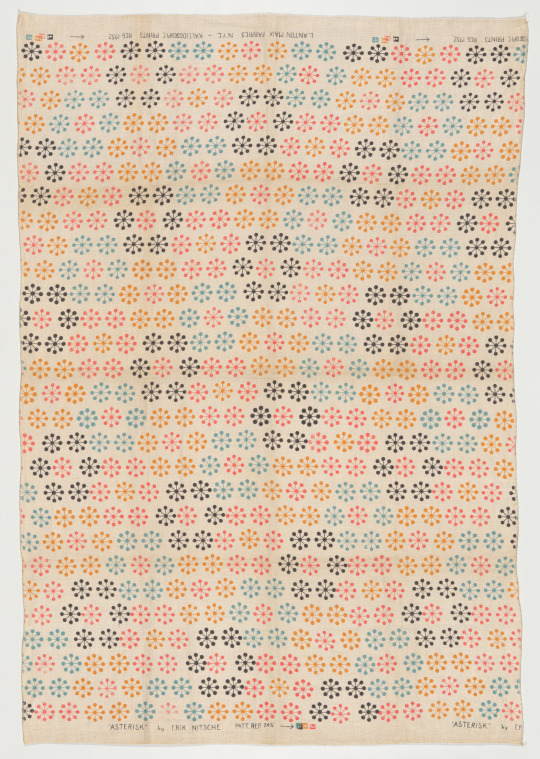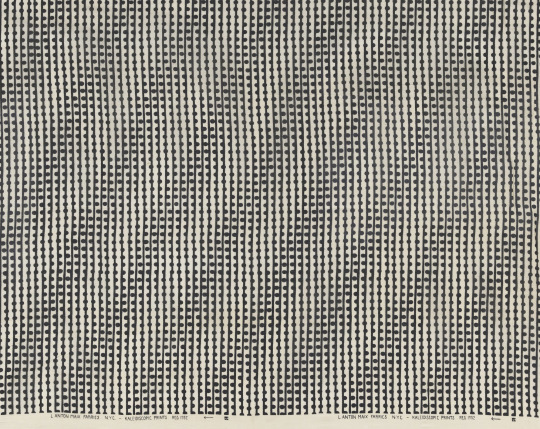#l. anton maix fabrics
Photo

Joel Robinson, Ovals textile, (screen-printed linen), L. Anton Maix Fabrics, New York, NY, ca. 1951 [MoMA, New York, NY]
#textile#fabric#interior design#geometry#pattern#joel robinson#l. anton maix fabrics#moma#the museum of modern art#1950s
169 notes
·
View notes
Text
Glen Plaid
“One of the most promising newcomers in the highly competitive field of fabric design is a youthful, multi-talented New Yorker, Joel Robinson,” Ebony magazine proclaimed in 1952.[1] Robinson’s printed fabric Ovals had been shown that winter in The Museum of Modern Art’s 1951 Good Design exhibition, making him the first African American to be included in the influential exhibition series, an achievement acknowledged in the multi-page article in Ebony. Jet magazine also covered the groundbreaking nature of his inclusion.[2] When the exhibition series ended in 1955, Robinson remained unique in this distinction.
At the time, Robinson was a 29-year-old native New Yorker working as a graphic designer in the advertising industry, first for pharmaceutical advertising agency William Douglas McAdams, and later as creative director and executive vice president at the David D. Polon Advertising Agency.[3] His celebrated fabric was produced by L. Anton Maix Fabrics. Maix was noted for his innovative collections of prints for the modern interior, often created in collaboration with artists and designers from other fields, including architect Serge Chermayeff, graphic designers Paul Rand and Alvin Lustig, industrial designer George Nelson, and furniture designers Jens Risom and Paul McCobb. After the success of Ovals, Maix introduced two Ovals variations and three additional designs by Robinson as part of his Kaleidoscope collection: Roman Candles, Honeycomb, and Glen Plaid, a fine linear design of interlocking bands of narrow rectangles in brown, yellow and red. A swatch book from the New York shop of Georg Jensen, also in the museum’s collection, includes Glen Plaid and other designs from the Kaleidoscope collection, illustrating the type of modern, design-forward retailer that promoted Maix’s fabrics.
Despite his breakout early success as a textile designer, there is no evidence to date that Robinson continued in the field after his first, groundbreaking collaborations with Maix. Former Cooper Hewitt Curatorial Fellow Andrew Gardner explored the sometimes-failed promise of the Good Design program in the essay “Lilly White”: Joel Robinson and Black Identity in MoMA’s Good Design Program.”
Susan Brown is an Associate Curator and Acting Head of the Textiles Department.
[1] N/A, “Fabric Designer,” Ebony, May 1952.
[2] N/A, “Exhibits Prize-Winning Fabrics,” Jet, December 13, 1951.
[3] N/A, “Named Vice Prexy of N.Y. Ad Firm,” Ebony, February 25, 1954.
from Cooper Hewitt, Smithsonian Design Museum https://ift.tt/32YbxrD
via IFTTT
19 notes
·
View notes
Photo

Joel Robinson, Roman Candles textile, (screen-printed linen), L. Anton Maix Fabrics, New York, NY, ca. 1951-1955 [MoMA, New York, NY]
#textile#fabric#interior design#geometry#pattern#joel robinson#l. anton maix fabrics#moma#the museum of modern art#1950s
107 notes
·
View notes
Photo

Joel Robinson, Ovals #2 textile (Drapery fabric), (screen-printed linen), L. Anton Maix Fabrics, New York, NY, 1954-1955 [MoMA, New York, NY]
#textile#fabric#interior design#geometry#pattern#joel robinson#l. anton maix fabrics#moma#the museum of modern art#1950s
82 notes
·
View notes
Photo

Joel Robinson, Gled Plaid, L. Anton Maix Fabrics, New York, NY, 1952 [Cooper Hewitt, Smithsonian Design Museum, New York, NY]
#textile#fabric#interior design#geometry#pattern#joel robinson#l. anton maix fabrics#cooper hewitt#smithsonian design museum#1950s
51 notes
·
View notes
Photo

Joel Robinson, Ovals #1 textile, (screen-printed linen), L. Anton Maix Fabrics, New York, NY, ca. 1951-1955 [MoMA, New York, NY]
40 notes
·
View notes
Photo

Joel Robinson, Ovals #2 textile, (screen-printed linen), L. Anton Maix Fabrics, New York, NY, ca. 1951-1955 [MoMA, New York, NY]
#textile#fabric#interior design#geometry#pattern#joel robinson#l. anton maix fabrics#moma#the museum of modern art#1950s
28 notes
·
View notes
Photo

Erik Nitsche, Asterisk (Furnishing Fabric), L. Anton Maix Fabrics, New York, NY, 1952 [MoMA, New York, NY]
(on the way of Flecha)
#design#art#textile#drawing#geometry#pattern#erik nitsche#l. anton maix fabrics#moma#the museum of modern art#1950s
196 notes
·
View notes
Photo

Herbert Bayer, Dot Dash Dot sheer fabric, L. Anton Maix Fabrics, New York, NY, ca. 1952 [MoMA, New York, NY]
#art#design#geometry#pattern#textile#herbert bayer#l. anton maix fabrics#moma#the museum of modern art#1950s
43 notes
·
View notes
Photo

Herbert Bayer, Kaleidoscope #2 (Furnishing fabric), L. Anton Maix Fabrics, New York, NY, ca .1952 [MoMA, New York, NY]
#art#design#geometry#pattern#textile#herbert bayer#l. anton maix fabrics#moma#the museum of modern art#1950s
18 notes
·
View notes
Text
Chips
In the aftermath of World War II, a number of textile producers attempted to revitalize the industry by enlisting recognized personalities in art and architecture to design screen prints. “Perhaps the most outstanding name collection is Stimulus Fabrics produced by Schiffer Prints,” Alvin Lustig wrote in American Fabrics Magazine in 1951. “There was not a professional fabric designer in the group, but nevertheless a distinguished collection was established.”[1]
Schiffer invited six architects, designers and artists, including Salvador Dali, Ray Eames, George Nelson, Bernard Rudofsky, Abel Sorenson, and Edward Wormley, to design textiles for the collection, which debuted at the Architectural League of New York. The New York Times hailed it as “Unquestionably the most brilliant single collection of all modern prints introduced since the war.”[2]
Some designs were to the trade only, and were available to architects and designers exclusively through L. Anton Maix. A different collection was sold to retail customers though department stores like W. and J. Sloane. Still others found their way into moderately priced apparel. Forty different designs were created between 1949 and 1962, when Schiffer closed.
Irving Harper, an employee of George Nelson Associates, designed Chips and six other prints that carry the George Nelson name.[3] Dark shading gives a three-dimensional effect to scattered abstracted shapes. The design was used on the cover of Schiffer’s 1950 brochure promoting the Stimulus collection. There are currently four George Nelson pieces in the collection: a chair, two clocks and a storage system.
Susan Brown is Associate Curator in the Textiles department at Cooper Hewitt, Smithsonian Design Museum.
[1] Alvin Lustig, “Modern Printed Fabrics,” Design, January 1956, p. 29
[2] New York Times, June 22, 1949.
[3] Jeffrey Head, “Pattern Languages: The Artistic Legacy of Schiffer Prints,” Modern, Summer 2014, p. 50
from Cooper Hewitt, Smithsonian Design Museum https://ift.tt/2GhhXWv
via IFTTT
6 notes
·
View notes